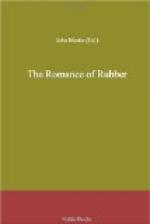Then he knew that he had made a real discovery and he named the process “vulcanizing” after Vulcan, the Roman god of fire. “Vulcanizing” means mixing pure rubber with certain chemicals and then applying heat. On this process, which is by no means simple, the great rubber business of the world has been established. Practically everything made of rubber, or of which rubber is a part, has to go through the vulcanizing process, whether it is a pair of Keds, a tire, a fruit jar ring, or a doormat.
So many people had been deceived by previous rubber ventures that Goodyear had great trouble in finding anyone with enough faith to invest money in his discovery. It was some time before he was able to take out the first of the more than sixty patents which he was granted during his lifetime for applying his process to various uses. Under these patents he licensed several factories to use the process in the manufacture of rubber goods, but required them to stamp all goods with the words “Goodyear patent.” Scores of companies have since used the name Goodyear, but the only factories that he licensed which are now in existence are parts of the United States Rubber Company.
Goodyear often had to defend his patents in court. In the most famous of these suits, he was defended by Daniel Webster and opposed by Rufus Choate, so that we see interwoven in the story of rubber the names of two of the greatest statesmen this country has produced.
CHAPTER 3
THE HEVEA TREE
For the very first of the rubber story we may thank a little wood-boring beetle, and the way nature has of helping her children to protect themselves.
The thistle of the meadow is as safe from hungry cattle as though fenced in by barbed wire. A cow must be starving that would care to flavor her luncheon with the needles that the thistle bears. The common skunk cabbage would make a tempting meal for her after a winter of dry feeding, had not Nature given it an odor that disgusts even a spring-time appetite. The milkweed welcomes the bees and flies that help to distribute her pollen where she wants it spread, but she has her own way of punishing the useless thieves that trespass up her stalk. Wherever the hooks of an insect’s feet pierce her tender skin, she pours out a milky juice to entangle its feet and body, and it is a lucky bug that succeeds in escaping before this juice hardens, and holds him a prisoner condemned to die.
All over the world there are plants with the same ability that the milkweed has, but it is especially true of certain trees and vines of the tropics. As soon as the little beetle begins to bore into the bark of one of these trees, there pours out a sticky, milky fluid that kills the insect at once. If this were all, the wound would remain open, ready for the next robber who came along. In order that the break may be healed, a cement is necessary, but not a hard, unyielding one, for that would crumble away with the motion of the tree in the wind.




